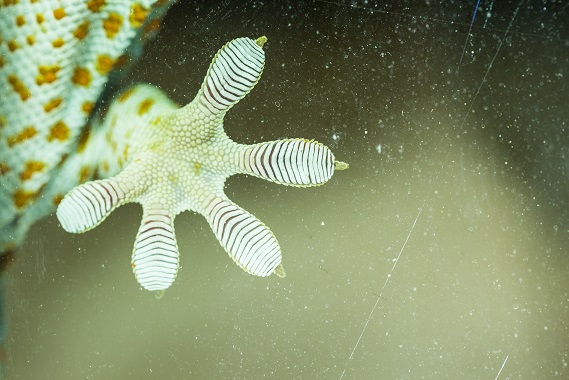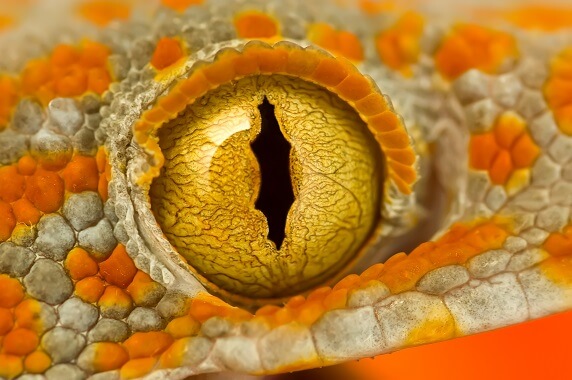
The tokay gecko (Gekko gecko) is the largest species of gecko. It is found across southeast and east Asia. These geckos are solid looking, with a large head and bulging eyes. They are light-blue to grey in color and covered in polka dot-like spots. There are two types of tokay gecko – the red-spotted and the black-spotted. Red-spotted tokay geckos are more widespread than the black-spotted, with populations found in Bangladesh, Nepal, the Philippines, Thailand, Indonesia, and the Indo-Australian Archipelago. Black-spotted tokay geckos are most likely to be found in northern Vietnam and mainland China. These geckos are arboreal and live in rainforests in trees and on cliffs. They have also been known to investigate human dwellings and will live in the nooks and crannies of a human home, where they feast on insects. Tokay geckos are nocturnal hunters. They are ambush hunters, meaning that they are more likely to sit and wait for prey than to forage for it actively. These lizards eat a wide variety of invertebrates, including moths, locusts, grasshoppers, beetles, cockroaches, termites, crickets, mosquitos, and spiders. They may also eat small rats, mice, and snakes. Tokay geckos have a long breeding season, which lasts approximately five months. Males will call out at the beginning of the season in the hope of finding a mate. Tokay geckos have a distinctive mating call, which sounds like “To-Kay” or “Gekk-Gekk.” These sounds are, in fact, responsible for both the common and scientific names of this species. During the breeding season, males will mate with several females. The females can lay new eggs every month. After mating, the female will search for a safe place to lay her eggs. Once a place is found, she will lay one or two eggs and attach them to a solid foundation. Both the male and the female take care of the eggs until they hatch. The young geckos take between two and six months to hatch. After hatching, they feed on the outer covering of their own skin. The young geckos are generally cared for by their parents until ten months of age when they go off alone. The juvenile geckos exhibit cannibalistic behavior and will sometimes eat young geckos of the same species! Humans are the main threat to tokay geckos. A large number of these lizards are caught every year. Some are sold as pets in Europe, the US, and Japan, and some are exported for use in traditional medicines across Asia. A large percentage of the lizards trapped are shipped to China, where they are used as ingredients in traditional medicine to treat asthma, diabetes, eczema, and more. Tokay geckos have some amazing biological adaptations that help them to survive in the wild. These lizards are known for their ability to climb any surface and are often spotted clinging to the ceiling when found in human dwellings. Not only are they great climbers, but they also have a great defense mechanism – they can detach their tail – which helps them to escape from predators! Let’s take a closer look at the biological concepts behind these characteristics! The tokay gecko has a fantastic defense mechanism against predators – it can shed its tail! The part of the tail that is shed can continue to move violently for several minutes, which gives the gecko time to escape. The geckos tail has several regions where it can break off. In these regions, the tissue is loosely joined and can easily break apart. This process is helped by the lizard contracting the muscles in its tail. Once gone, the gecko is not without a tail for long! The gecko’s tail takes approximately three weeks to regenerate, although it is typically shorter than the original. There are several other animals that can regenerate tails, and some can even regenerate limbs and organs! For example, the axolotl can regrow entire limbs and parts of its major organs, starfish can regrow their arms, and sea cucumbers can regenerate whole organs! Geckos are famous for their ability to scale walls and hang upside down on ceilings. They can accomplish this due to the sticky pads on their feet. The pads are made up of hundreds and hundreds of tiny hairs. These microscopic hairs are collectively called setae. Each seta splits off into hundreds of even smaller hairs called spatulae. The tufts of tiny hairs found on the gecko’s feet get so close to the contours in the walls and ceilings that Van der Waals force kicks in. Van der Waals force is an interaction between atoms and molecules that is distance dependant. Unlike chemical bonds, this force is quite weak and becomes disrupted as distance increases between the molecules involved. The electrons in the hair molecules on a gecko’s feet interact with electrons from the wall molecules, which creates an electromagnetic attraction. Like most geckos, tokay geckos have no eyelids. Instead, the eyes of a tokay gecko are covered with transparent scales. These scales function as protective lenses and stop their eyes from becoming dry. The lizards use their long tongues to remove debris and clean the scales, keeping their eyes clean. Tokay geckos shed these scales like they shed the rest of their skin. Geckos are not the only animals to have eye scales. Snakes also possess scales, known as spectacles, instead of eyelids. Another fun fact about a gecko’s eye is that it can only see black and white. As geckos are nocturnal, there is no need for them to be able to see in color!
Kingdom
Animalia
Phylum
Chordata
Class
Reptilia
Order
Squamata
Family
Gekkonidae
Genus
Gekko
Species
Gekko gecko
Length
Males: 13-16 inches (35-40 cm). Females: 8-12 inches (20-30 cm).
Weight
5 oz – 14 oz (150 g – 400 g)
Lifespan
Up to 10 years
Social Structure
Solitary
Status
Least Concern
Preferred Habitat
Trees and cliffs
Average Clutch size
2
Main food item
Invertebrates such as moths, locusts, grasshoppers, and spiders.
Main predators
Large, venomous snakes
The Basics

Fun Facts about the Tokay Gecko!
Detachable Tail

Sticky Pads

Eye Scales
